Circuit breakers operate on the premise of mechanical or electronic detection of abnormal currents, promptly opening their contacts to halt the circuit’s flow. Conversely, fuses rely on a simpler yet effective approach, utilizing a metal or wire strip that melts when confronted with excessive current, thus breaking the circuit. Despite their shared objective, each component brings its own set of advantages and limitations to the table.
Throughout this exploration, we will delve into the nuances of circuit breakers and fuses, delving into factors such as response time, reliability, resetability, and adaptability to diverse electrical loads. By comprehensively comparing and contrasting these protective devices, readers will glean insights crucial for informed decision-making when safeguarding electrical systems.
What Is a Circuit Breaker and How Does It Work?
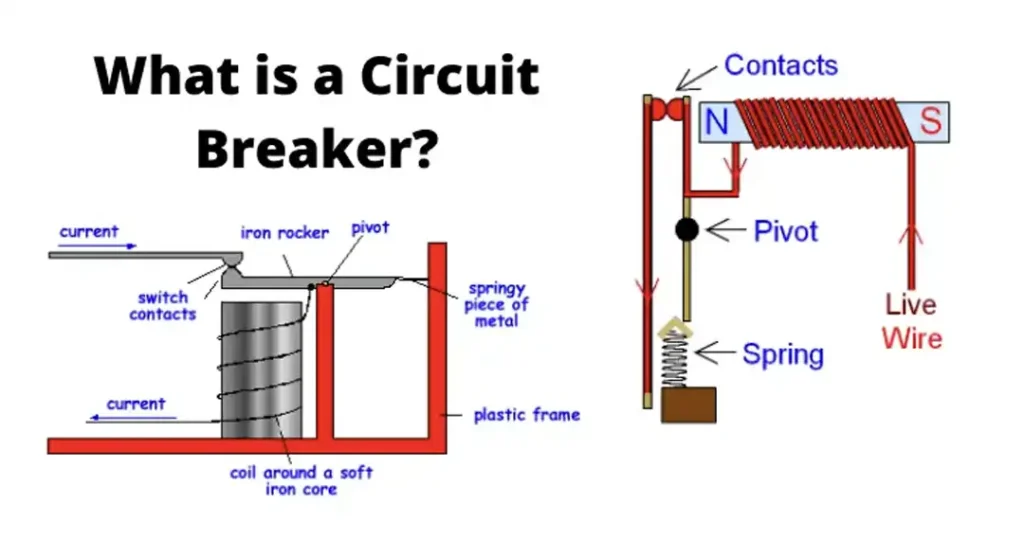
A circuit breaker is a crucial electrical component designed to protect electrical circuits and equipment from damage caused by overcurrents, short circuits, and other electrical faults. It acts as a safety mechanism by automatically interrupting the flow of electricity when it detects abnormal conditions within the circuit it safeguards.
How a Circuit Breaker Works:
- Detection of Fault: Circuit breakers are equipped with sensors or mechanisms that monitor the flow of current through the circuit. When an overcurrent or fault occurs, such as when the current exceeds the breaker’s rated capacity or a short circuit occurs, the circuit breaker detects the abnormal condition.
- Trip Mechanism: Upon detecting a fault, the circuit breaker initiates a trip mechanism. This mechanism is designed to swiftly open the circuit by moving its internal contacts from a closed position to an open position. By opening the circuit, the circuit breaker interrupts the flow of electricity, preventing further damage or hazards.
- Isolation of Fault: Once the circuit breaker trips and interrupts the flow of current, it effectively isolates the faulty portion of the circuit from the rest of the electrical system. This isolation prevents the fault from spreading to other connected devices or circuits, minimizing the extent of damage and maintaining safety.
- Resetting: After the fault condition is resolved and the circuit breaker has tripped, it can be manually reset to restore power to the circuit. Depending on the type of circuit breaker, this may involve simply flipping a switch or pressing a button to reset the breaker’s contacts to their closed position. Some circuit breakers also feature automatic reset capabilities, which attempt to restore power after a brief delay once the fault is cleared.
Circuit breakers play a critical role in safeguarding electrical systems and equipment by detecting and interrupting abnormal conditions in circuits. Their ability to quickly respond to faults helps prevent electrical fires, damage to equipment, and other hazards, making them essential components in residential, commercial, and industrial electrical installations.
What Is the Fuse and How Does It Work?
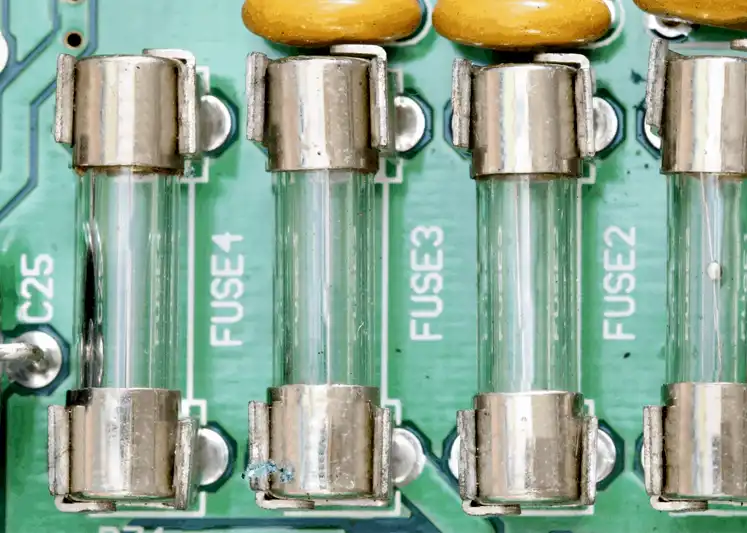
A fuse is an electrical safety device designed to protect electrical circuits and equipment from damage caused by overcurrents. It operates by interrupting the flow of electricity when it detects excessive current flow, thereby preventing potential hazards such as electrical fires or damage to connected devices.
How Does a Fuse Work?
- Fuse Element: The core component of a fuse is a thin strip of metal or wire known as the fuse element. This element is typically made of materials such as copper, silver, or alloys with specific melting points.
- Rated Current: Fuses are rated to carry a specific current without interruption. When the current flowing through the circuit exceeds the fuse’s rated capacity, the fuse element heats up due to the increased resistance.
- Melting of Fuse Element: As the current exceeds the rated capacity, the temperature of the fuse element rises. Once the temperature reaches a critical point, the fuse element melts or “blows,” effectively breaking the circuit.
- Circuit Interruption: When the fuse element melts, it creates an air gap in the circuit, preventing further flow of electricity. This interruption of the circuit stops the excessive current flow and protects the electrical system from damage.
- Protection: By interrupting the circuit in response to overcurrent conditions, the fuse protects connected devices and wiring from overheating and potential damage. This helps prevent electrical fires and ensures the safety of the electrical installation.
Once a fuse has blown and interrupted the circuit, it must be replaced with a new fuse of the appropriate rating to restore power to the circuit. Unlike circuit breakers, which can be reset manually or automatically after tripping, fuses are typically single-use devices and must be replaced each time they operate.
Fuses serve as essential safety devices in electrical systems, providing reliable protection against overcurrents and helping to maintain the integrity and safety of electrical installations.
Circuit Breaker vs Fuse
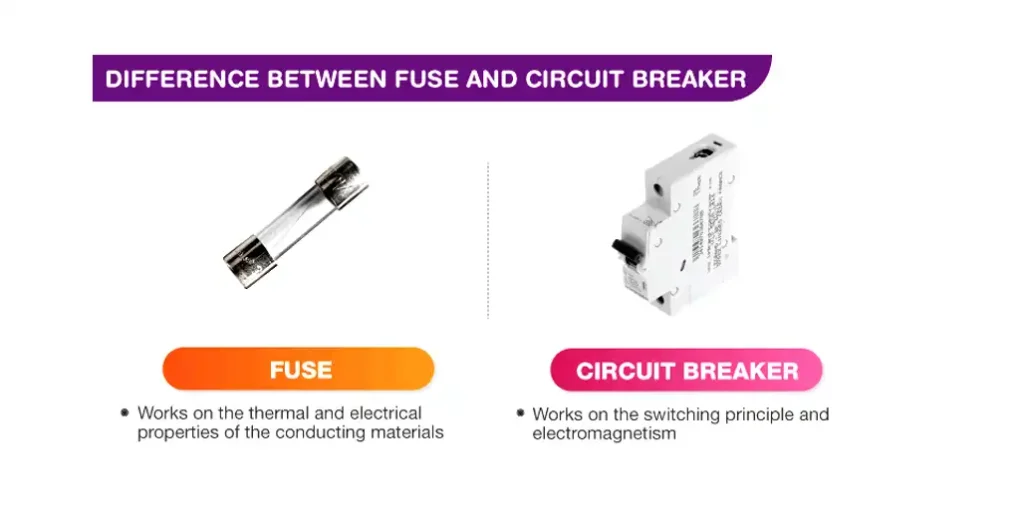
Circuit breakers and fuses are both essential components in electrical systems, serving to protect circuits and equipment from damage caused by overcurrents and faults. While they share the common goal of interrupting electrical flow to prevent hazards, there are notable differences between the two in terms of their mechanisms, operation, and applications.
Circuit Breaker:
- Mechanism: Circuit breakers use mechanical or electronic mechanisms to detect abnormal currents and faults in circuits. When a fault is detected, the circuit breaker trips, opening its contacts to interrupt the flow of electricity.
- Resetability: Circuit breakers can be manually or automatically reset after tripping, restoring power to the circuit once the fault is resolved.
- Reusability: Circuit breakers are reusable devices that can trip multiple times without needing replacement, making them convenient for ongoing protection.
- Flexibility: Circuit breakers offer flexibility in terms of trip settings and adjustment, allowing for customization based on specific circuit requirements.
Fuse:
- Mechanism: Fuses rely on a thin strip of metal or wire known as the fuse element, which melts when exposed to excessive current flow. This melting breaks the circuit and interrupts the flow of electricity.
- Non-Resettable: Fuses are typically single-use devices that must be replaced after operating (blowing) to restore power to the circuit.
- Simplicity: Fuses operate on a simple principle of melting the fuse element when current exceeds the rated capacity, offering a straightforward and reliable method of protection.
- Cost: Fuses are generally less expensive than circuit breakers, making them a cost-effective option for basic protection in some applications.
| Aspect | Circuit Breaker | Fuse |
|---|---|---|
| Mechanism | Uses mechanical or electronic mechanisms to detect | Relies on a fuse element that melts when exposed to |
| abnormal currents and faults, tripping to interrupt | excessive current flow, breaking the circuit | |
| Resetability | Can be manually or automatically reset after tripping | Typically single-use devices that must be replaced |
| to restore power to the circuit | after operating (blowing) | |
| Reusability | Reusable device that can trip multiple times without | Single-use device that needs replacement after |
| needing replacement | operating | |
| Flexibility | Offers flexibility in trip settings and adjustment | Operates on a simple principle of melting the fuse |
| element when current exceeds the rated capacity | ||
| Cost | Generally more expensive than fuses | Typically less expensive than circuit breakers |
This table summarizes the key differences between circuit breakers and fuses in terms of their mechanisms, resetability, reusability, flexibility, and cost.
Circuit Breaker vs Fuse Box
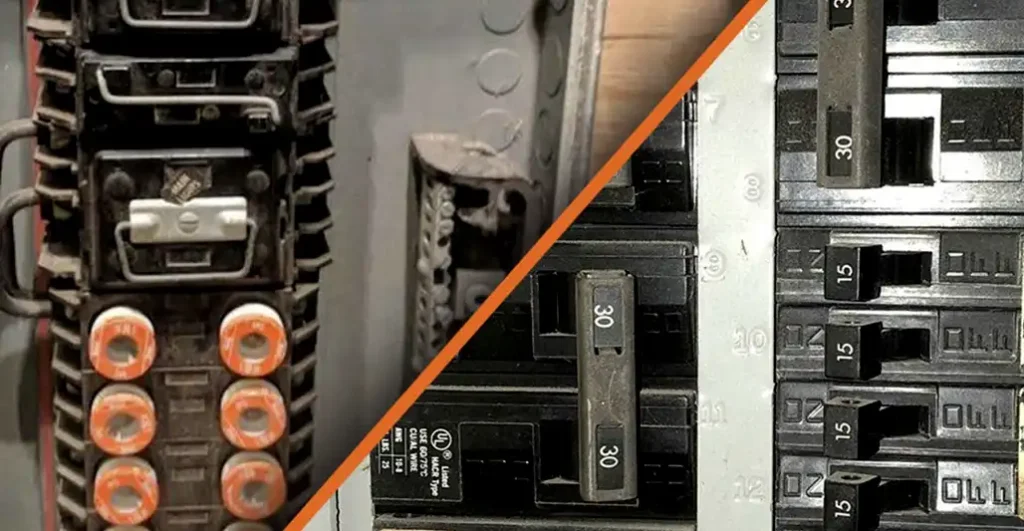
When comparing a circuit breaker to a fuse box, it’s important to understand that they serve similar functions but employ different mechanisms for protecting electrical circuits. Here’s a breakdown of the differences between the two:
Circuit Breaker:
- Mechanism: Circuit breakers use switches or electronic components to monitor and control the flow of electricity in circuits. They trip and interrupt the circuit when they detect abnormal conditions such as overcurrents or short circuits.
- Resetability: Circuit breakers can be manually or automatically reset after tripping, restoring power to the circuit once the fault is resolved.
- Reusability: Circuit breakers are reusable devices that can trip multiple times without needing replacement, offering ongoing protection for electrical circuits.
- Space Efficiency: Circuit breakers are typically more compact and occupy less space compared to a fuse box, making them suitable for modern electrical installations where space is limited.
Fuse Box:
- Mechanism: A fuse box contains individual fuses for each electrical circuit. Fuses consist of a thin metal wire that melts when exposed to excessive current, breaking the circuit and interrupting the flow of electricity.
- Non-Resettable: Fuses are typically single-use devices that must be replaced after operating (blowing) to restore power to the circuit.
- Replacement: When a fuse blows, it needs to be replaced with a new fuse of the appropriate rating. This process involves physically replacing the fuse in the fuse box.
- Legacy Systems: Fuse boxes are commonly found in older homes and buildings that were constructed before the widespread adoption of circuit breakers. While they are effective at protecting circuits, they lack the convenience and flexibility of modern circuit breaker panels.
Circuit breakers offer the advantages of resetability, reusability, and space efficiency, making them a preferred choice for modern electrical installations. Fuse boxes, on the other hand, are often found in older buildings and operate using replaceable fuses, which must be replaced manually after they blow.
| Aspect | Circuit Breaker | Fuse Box |
|---|---|---|
| Mechanism | Uses switches or electronic components to monitor and | Contains individual fuses for each electrical circuit, |
| control the flow of electricity in circuits. Trips and | which consist of a thin metal wire that melts when | |
| interrupts the circuit when abnormal conditions are | exposed to excessive current, breaking the circuit and | |
| detected. | interrupting the flow of electricity. | |
| Resetability | Can be manually or automatically reset after tripping | Fuses are typically single-use devices that must be |
| to restore power to the circuit. | replaced after operating (blowing) to restore power to | |
| the circuit. | ||
| Reusability | Reusable devices that can trip multiple times | Fuses are single-use devices and need to be replaced |
| without needing replacement. | each time they operate. | |
| Space Efficiency | Typically more compact and occupy less space compared | May take up more space due to the presence of multiple |
| to a fuse box, suitable for modern electrical | fuses for each circuit. | |
| installations. | ||
| Application | Commonly found in modern electrical installations, | Often found in older homes and buildings constructed |
| providing convenience and flexibility. | before the widespread adoption of circuit breakers. |
This table summarizes the key differences between a circuit breaker and a fuse box in terms of their mechanisms, resetability, reusability, space efficiency, and application.
Automotive Circuit Breaker vs Fuse
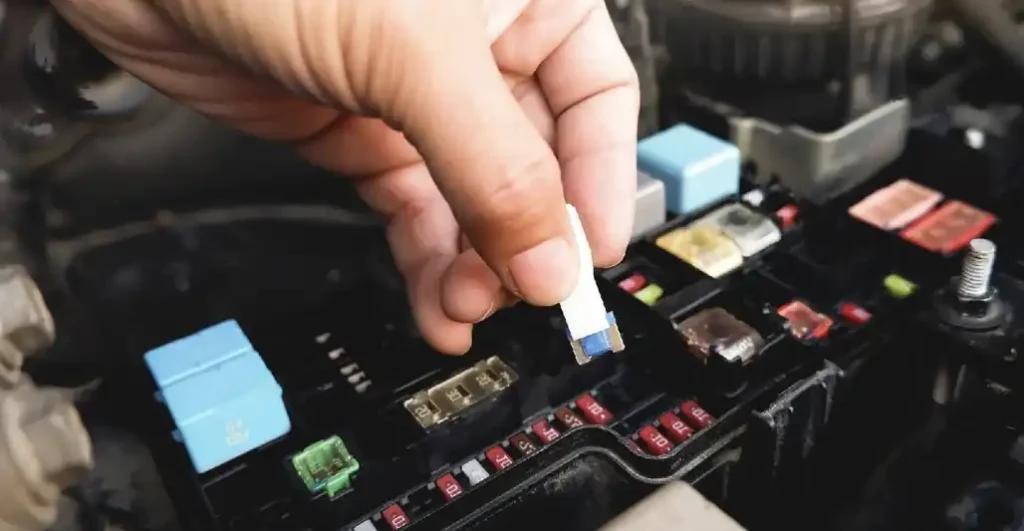
| Aspect | Automotive Circuit Breaker | Automotive Fuse |
|---|---|---|
| Mechanism | Utilizes a mechanical or electronic mechanism to detect and | Contains a thin strip of metal that melts when exposed to |
| interrupt excessive current flow in the vehicle’s electrical | excessive current flow, breaking the circuit and interrupting | |
| system. | the flow of electricity. | |
| Resetability | Can be manually or automatically reset after tripping to | Typically a one-time use device that must be replaced after it |
| restore power to the circuit. | blows. | |
| Reusability | Reusable device that can trip multiple times without needing | Single-use device that requires replacement each time it |
| replacement. | operates. | |
| Response Time | Rapid response time to protect electrical circuits and | Offers a quick response time to protect electrical systems |
| components from damage. | from damage. | |
| Application | Commonly used in automotive electrical systems to protect | Found in automotive electrical systems to safeguard against |
| against overcurrents and short circuits. | overcurrents and short circuits. | |
| Space Efficiency | Typically compact and designed to fit within the vehicle’s | Occupies minimal space within the vehicle’s fuse box or |
| fuse box or distribution panel. | distribution panel. | |
| Adaptability | Provides flexibility with various trip ratings and can be | Available in different amperage ratings to suit specific |
| tailored to specific circuit requirements. | circuit requirements. |
This table outlines the key differences between an automotive circuit breaker and a fuse in terms of their mechanisms, resetability, reusability, response time, application, space efficiency, and adaptability.
Conclusion
In conclusion, while both circuit breakers and fuses serve the fundamental purpose of protecting electrical circuits from overcurrents and faults, they operate on different principles and offer unique advantages.
Circuit breakers utilize mechanical or electronic mechanisms to monitor and control current flow, providing the benefits of resetability, reusability, and flexibility in trip settings. On the other hand, fuses rely on a simple melting process to interrupt current flow, offering the advantages of quick response time and cost-effectiveness.
The choice between a circuit breaker and a fuse depends on various factors such as the specific application, desired level of protection, and budget considerations. Circuit breakers are commonly preferred in modern electrical installations due to their convenience, reliability, and adaptability, while fuses remain suitable for certain applications, especially in older systems or where cost is a primary concern.




















